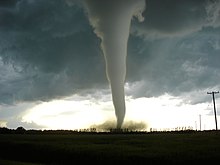It has been suggested that this article should be split into a new article titled List of Canadian tornadoes and tornado outbreaks in the 2020s. (discuss) (June 2023) |

This is a list of notable tornadoes, tornado outbreaks, and tornado outbreak sequences that have occurred in Canada in the 21st century. (2001 through 2100). Due to increasing detection, particularly in the US and southern Canada, numbers of counted tornadoes have increased markedly in recent decades although number of actual tornadoes and counted significant tornadoes has not. In older events, the number of tornadoes officially counted is likely underestimated.
On average, there are around 80 confirmed and unconfirmed tornadoes that touch down in Canada each year, with most occurring in the southern Canadian Prairies, Southern Ontario and southern Quebec. Canada ranks as the second country in the world with the most tornadoes per year, after the US. The most common types are F0 to F2 in damage intensity level and usually result in minor structural damage to barns, wood fences, roof shingles, chimneys, uprooted or snapped tree limbs and downed power lines. Fewer than 5% of tornadoes in Canada are rated F3 or higher in intensity, where wind speeds are in excess of 225 km/h (140 mph). Prior to April 1, 2013, Canada used a slightly modified Fujita scale, and as of that date the Enhanced Fujita scale, again slightly modified, was put into use to rate tornado intensity, based on the damage to buildings and vegetation.[1]
Each year on average, about 43 tornadoes occur across the Canadian Prairies and about 17 occur across Ontario and Quebec.[2] New Brunswick and the British Columbia Interior are also recognized tornado zones. All other provinces and territories have significantly less threat from tornadoes. The peak season in Canada is through the summer months, (June to August), when clashing air masses move north, as opposed to the spring season in the United States southern-central plains, although tornadoes in Canada have occurred in spring, fall and very rarely winter.
The reported increase in numbers of tornadoes in recent years may reflect more reporting by citizens and media involvement rather than an actual increase in tornado occurrence (although some natural increase has not been ruled out), in addition to better detection technology i.e. Doppler weather radar and satellite imagery. The upswing could also be attributed to other factors, such as improved aerial and ground damage assessment after the fact in sparsely populated areas (particularly the case in remote parts of the Canadian Prairies and Northern Ontario, for example), better trained spotter capabilities and increased use of digital recording devices by citizens. The Northern Tornadoes Project attempts to gather more systematic data on tornado prevalence.[3] Tornadoes in Canada are enough of a threat for a public warning system to be in place, overseen by the national weather agency, Environment Canada (EC).
For a variety of reasons, such as Canada's lower population density and generally stronger housing construction due to the colder climate, Canadian tornadoes have historically caused far fewer fatalities than tornadoes in the United States. The deadliest tornado in Canadian history, the Regina Cyclone of June 30, 1912, does not even rank in the top 25 when compared to American tornado fatalities. Urban centres are not immune from the threat of severe tornadoes. Twelve medium to large size Canadian cities have been hit by significant strength tornadoes (F3/EF3 or higher), which caused large-scale damage and fatalities: Toronto (1868); Regina (1912); Windsor (1946 and 1974); Sarnia (1953); LaSalle (1956); Sudbury (1970); Woodstock (1979); Lloydminster (1983); Barrie (1985); Edmonton (1987); Aylmer (1994 and 2018); and Ottawa-Gatineau (1888 and 2018).
All figures for damages are in Canadian dollars.
- ^ "Enhanced Fujita Scale (EF-Scale)". 10 May 2013. Archived from the original on 2017-04-07. Retrieved 2017-02-09.
- ^ "Environment and Climate Change Canada - Spring and summer weather hazards". 2017-02-03. Retrieved 2020-06-18.
- ^ Whang, Oliver (10 March 2023). "O Canada, Where Are All Your Tornadoes?". The New York Times. Retrieved 10 March 2023.
© MMXXIII Rich X Search. We shall prevail. All rights reserved. Rich X Search
